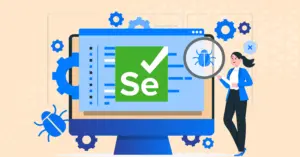It’s not always easy to write and maintain test automation code. Actually, debugging is the only option in many scenarios where automated test cases don’t function as intended and could produce false positive or false negative results. The main set of skills that an automation tester needs to master is debugging. It boosts automation testers’ confidence and morale to offer a better code solution to end the issue once and for all.
A large number of test cases in the test automation framework makes debugging issues related to the framework more difficult. The quantity of test cases progressively rises as the application’s functionalities are added. Under such circumstances, debugging approaches may need to be improved in order to fix complicated hybrid framework difficulties. We will delve further into these fundamental debugging approaches in this article, which will not only help you solve script bugs quickly, but also save a significant amount of time when debugging. Check out the Selenium certification course to learn more.
What is Debugging?
To put it simply, debugging is the process of using different debugging techniques to find and fix errors in the source code in software engineering. There are essentially four common steps of debugging:
- Identification: Finding the issue and trying to replicate it on the local system are the initial steps in debugging, since they will help determine the cause of the problem. This is a crucial phase because, in order to implement a long-term remedy, we must determine the underlying source of the problem.
- Isolation: The goal of this second stage is to distinguish between the healthy code and the problematic code. Unit testing of defective code is necessary to determine the actions that must be taken in order to resolve the problem. Isolating problematic code would further reduce time and not affect the other code.
- Resolution: This is the first step in fixing the buggy code. This step depends on the previous two phases; after those two are finished, the resolution can be implemented.
A few tips for fixing the code:
- Take a close look at the code and libraries being utilised to see how the framework operates.
- Consult the appropriate document and StackOverflow solutions.
- Run the program in debug mode.
- Conduct unit testing and a code tour on the local system.
- In the worst situation, rework or redesign the framework architecture.
- Review: Developers typically attempt to omit this last step of debugging. To make sure the deployed fix is functioning properly and isn’t interfering with other code. The review should ideally be completed by the two developers—the one who actually changed the buggy code and the other who is in charge of examining and approving the code merging.
What is Parallel Execution?
Instead of doing tests one after the other, parallel execution entails doing so simultaneously. This is very helpful for lengthy test suites that require a lot of processing time. You can significantly reduce the execution time by spreading the tests across several threads or processes.
Challenges with Debugging Parallel Tests
- Shared Resources: Tests that run in parallel may have access to shared resources such as databases or files. If not handled correctly, this could lead to disputes.
- Non-deterministic Failures: Occasionally a test that passes when performed alone may fail when run in parallel. Debugging these non-deterministic failures is challenging.
- Isolation of Logs: When several tests are executed simultaneously, logs may mix up, making it challenging to identify which log statements are related to which test.
Strategies for Debugging
- Resource Isolation: Make that every test has its own resources (different file names, distinct database instances, etc.).
- Using Thread-Safe Coding Techniques: Use safe coding techniques when working in multi-threaded systems. For example, don’t use static variables that many threads can access.
- Structured Logging: Use structured logging in which every log entry is identified by the particular test or thread to which it pertains. This will assist with the log filtering process for a certain test.
- Failing Fast: Set up your test runner to terminate after the first failure, if at all possible. This makes it simpler to concentrate on fixing the first problem before moving on.
- Running Tests in Isolation: If a test does not pass when executed in parallel, conduct it separately to ascertain whether the issue is with parallel execution or an issue with the test itself.
What is Selenium Grid?
A component of the Selenium Suite, Selenium Grid is designed to run numerous tests in parallel on various machines, operating systems, and browsers. There are two primary parts to it: the Hub and the Nodes. The Hub serves as a central location where the test to be run is received together with details about the appropriate browser and “OS” settings. The computers known as nodes are those that are connected to the hub and will run the tests on the preferred platform and browser.
Setting the Selenium Grid
- Download Selenium Server: Visit the Selenium website to get the Selenium Server (Grid).
- Launch the Hub: Navigate to the location of the Selenium Server jar file using a command-line tool, then use the command to launch the hub.
- Register Nodes: Navigate to the Selenium Server jar file’s location on each node system, then use the command to register the node.
Debugging Strategies
- Browser-Specific Issues: Occasionally, a problem could be limited to a certain browser. You must determine whether your test or the browser’s rendering is the issue.
- Examining Compatibility: Make sure the browser versions you are using are compatible with the Selenium bindings.
- Log Analysis: To identify any problems with communication between the Hub and Nodes, examine the logs that Selenium Grid has produced.
- Visual Inspection: Occasionally, problems may arise from the way items appear in various browsers. This is where visual inspection comes in handy.
- Isolate Issues: To determine if the problem lies with the Grid configuration or the test itself, consider running the test locally on the same browser and OS combination if it fails on one of the node machines.
Conclusion
To learn more about how Debugging in Selenium works, check out our Selenium online training.



























